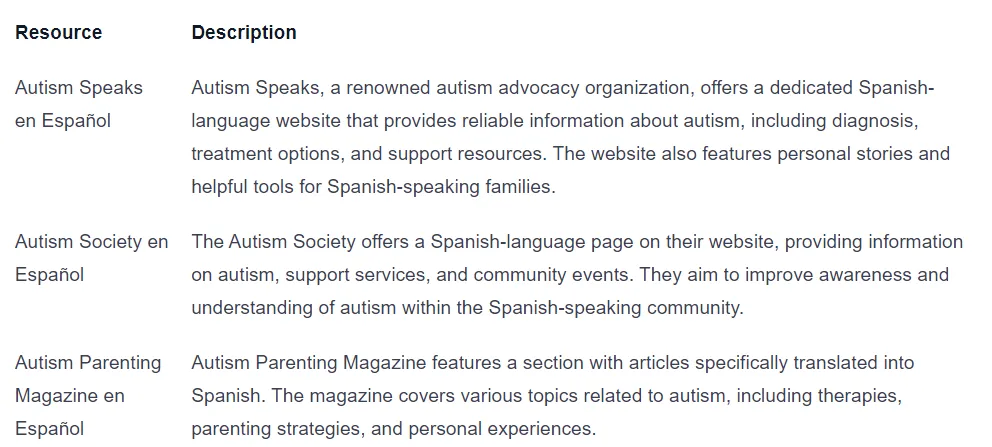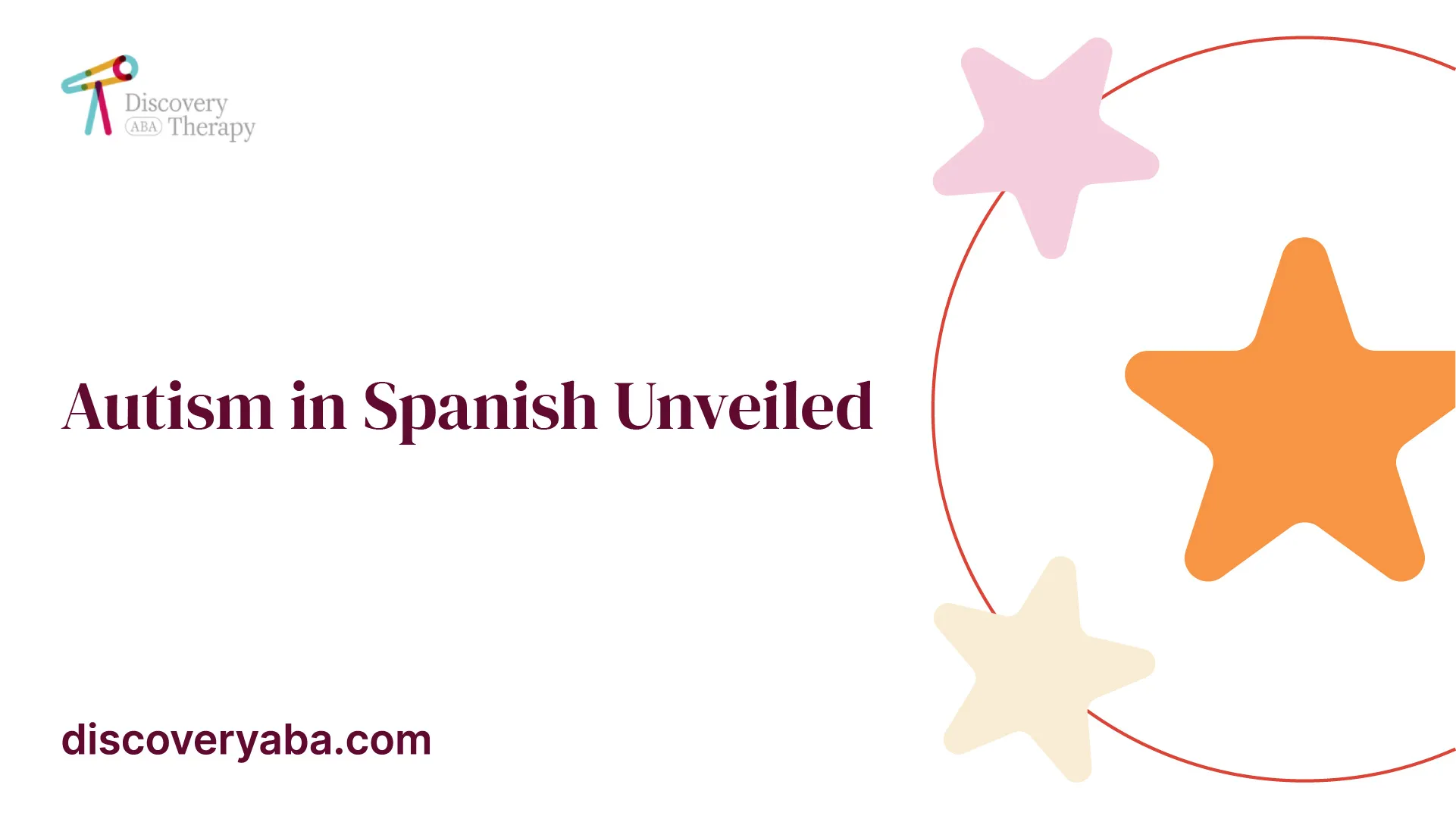Autism in Spanish Unveiled
Unlocking autism in Spanish! Discover the challenges, resources, and solutions for Spanish-speaking communities affected by autism.

Understanding Autism
Autism is a complex neurodevelopmental disorder that affects individuals' social skills, communication abilities, and behavior. It is characterized by a range of challenges and strengths, with each person experiencing autism in a unique way.
What is Autism?
Autism, also known as Autism Spectrum Disorder (ASD), is a lifelong condition that typically emerges in early childhood. It affects how individuals perceive and interact with the world around them. Common characteristics of autism include difficulties in social communication and interaction, repetitive behaviors, and sensory sensitivities.
Individuals with autism may struggle with social cues, such as maintaining eye contact, understanding nonverbal gestures, and engaging in reciprocal conversations. They may also exhibit repetitive behaviors, such as hand-flapping, rocking, or lining up objects. Sensory sensitivities, such as being overwhelmed by loud noises or certain textures, are also common among individuals with autism.
Although the exact causes of autism are still being studied, it is believed to arise from a combination of genetic and environmental factors. There is no known cure for autism, but early intervention and appropriate support can greatly enhance an individual's quality of life.

Prevalence of Autism in Spanish-Speaking Communities
Research specifically focused on the prevalence of autism within Spanish-speaking communities is limited. However, studies in the United States have indicated that the prevalence of autism among Black and Latino children has increased to 13.4%, compared to 7.7% in white children. This suggests that autism is now more common among Black and Latino children in the U.S. than among white children.
In Spain, a large epidemiological study reported an estimated prevalence rate of 1 in 150 individuals for autism spectrum disorder, which aligns with global prevalence rates described in the literature [2]. However, more research is needed to fully understand the prevalence of autism within Spanish-speaking communities worldwide.
Understanding the prevalence of autism in Spanish-speaking communities is crucial for developing targeted intervention programs, ensuring access to appropriate resources, and promoting awareness and acceptance. By recognizing the unique challenges faced by individuals with autism and their families within Spanish-speaking communities, we can work towards bridging the language gap and providing the support necessary for individuals with autism to thrive.
Challenges in Autism Diagnosis and Recognition
Recognizing and diagnosing autism in the Latino community comes with unique challenges. These challenges can lead to delayed diagnoses and hinder access to essential resources and support. Two significant factors that contribute to these difficulties are delayed diagnosis in Latino children and cultural factors affecting autism recognition.
Delayed Diagnosis in Latino Children
Research indicates that Latino children are diagnosed with Autism Spectrum Disorder (ASD) approximately 2.5 years later than their white non-Latino counterparts in the United States [1]. This delay in diagnosis can have significant implications for early intervention and access to appropriate support services.
The reasons behind this delayed diagnosis are multifactorial. One contributing factor is a lack of awareness and knowledge about autism within the Latino community. Limited familiarity with the early signs and symptoms of autism may prevent parents from seeking professional evaluation for their children.
Cultural Factors Affecting Autism Recognition
Cultural factors also play a role in the recognition and understanding of autism within the Latino community. Latino parents may have different beliefs and perceptions regarding parenting, disability, and mental health [3]. For instance, they may interpret certain behavioral and emotional issues in their children as "emotional" or "personality" factors rather than indicators of a potential mental health condition such as autism.
These cultural beliefs and interpretations can hinder the identification of early signs of autism and delay the decision to seek medical attention for their child's condition. The reluctance to recognize behavioral and emotional problems as having a mental health basis may result in missed opportunities for early intervention and support.
Addressing these challenges requires raising awareness and providing culturally sensitive resources and information within the Latino community. In doing so, it becomes possible to bridge the gap in autism diagnosis and recognition, ensuring that all children, regardless of their cultural background, receive timely and appropriate support for their unique needs.
Autism Resources for Spanish Speakers
When it comes to accessing information and support for autism, it is essential to ensure that resources are available in different languages to cater to diverse communities. For Spanish speakers seeking autism-related resources, there is a growing need to bridge the gap and provide accessible information in their native language.
Spanish-Language Websites and Organizations
Efforts have been made to address the lack of quality resources available in Spanish for families of individuals with autism in the United States. Several websites and organizations are dedicated to providing valuable information and support in Spanish. These resources play a crucial role in empowering Spanish-speaking families and individuals affected by autism.

Addressing the Resource Gap for Spanish-Speaking Families
Despite efforts to provide Spanish-language resources, there is still a significant gap in access to quality information and support services for Spanish-speaking families affected by autism. This gap is exacerbated by the scarcity of diagnostic, evaluation, and intervention services available in Spanish, hindering the development and dissemination of relevant materials in Spanish for the autism community.
To address this resource gap, it is crucial to continue creating new resources and translating existing ones. Organizations and professionals in the field of autism should collaborate to develop Spanish-language materials that cover a wide range of topics, from early intervention strategies to educational resources and support networks.
Additionally, efforts should be made to increase the availability of diagnostic, evaluation, and intervention services in Spanish. By expanding access to these vital services, families can receive the support they need, and professionals can better understand and address the unique needs of Spanish-speaking individuals with autism.
By working towards these goals, we can strive for a more inclusive and supportive environment for Spanish-speaking families affected by autism. It is essential to recognize the importance of language accessibility and ensure that resources are available to empower and assist Spanish-speaking individuals in their autism journey.
Improving Access to Autism Services for Spanish Speakers
When it comes to autism services, it is crucial to ensure that individuals and families who primarily speak Spanish have access to the support and resources they need. However, there are several challenges that need to be addressed in order to bridge the gap and improve access for Spanish speakers.
Language Barriers and Communication Challenges
Language barriers can pose significant challenges when it comes to diagnosing autism in Spanish-speaking individuals. Providers who lack proficiency in Spanish may struggle to effectively communicate with patients and their families, which can hinder accurate assessment and diagnosis [1]. Clear and effective communication is essential to understanding the needs and experiences of individuals with autism, as well as their families.
To overcome language barriers, it is important to have bilingual professionals who are proficient in both Spanish and English. These professionals can serve as a bridge, ensuring that information is accurately communicated and understood. Additionally, providing translated materials and resources in Spanish can help Spanish-speaking families access important information about autism and available services.
Promoting Cultural Competence in Healthcare
Cultural factors play a significant role in healthcare, including the diagnosis and treatment of autism. It is important for healthcare professionals to be culturally competent and sensitive to the unique experiences and needs of Spanish-speaking individuals and families.
Promoting cultural competence involves understanding and respecting cultural differences, beliefs, and values. This includes recognizing the impact of culture on perceptions of autism and seeking to provide culturally appropriate care. By fostering an environment of trust and understanding, healthcare providers can create a safe space where Spanish-speaking individuals and families feel comfortable seeking and receiving autism services.
Training healthcare professionals on cultural competence and sensitivity is essential. This training can help providers understand the cultural nuances and beliefs surrounding autism in Spanish-speaking communities. It can also promote effective communication and strengthen relationships between healthcare providers and Spanish-speaking families.
By addressing language barriers and promoting cultural competence in healthcare, we can work towards improving access to autism services for Spanish speakers. This will ensure that all individuals, regardless of language or cultural background, have equal opportunities to receive the support and care they need.
Overcoming Barriers to Early Intervention
Early intervention is crucial for children with autism to receive the necessary support and services for their development. However, there are several barriers that can hinder timely intervention for Hispanic/Latinx families affected by autism. Two key areas that need attention are raising awareness and education, as well as providing support specifically tailored to these families.
Raising Awareness and Education
One of the primary challenges faced by Hispanic/Latinx families is the lack of awareness and understanding of autism. Research has shown that Latino parents may be less likely to recognize behavioral and emotional problems in their children as having a mental health basis, instead attributing them to "emotional" or "personality" factors [1]. This attribution can hinder the identification of potential autism symptoms and delay seeking medical attention for their child's condition.
To overcome this barrier, it is essential to focus on raising awareness and providing education about autism within the Hispanic/Latinx community. This can be achieved through community outreach programs, workshops, and informational resources in Spanish that explain the signs and symptoms of autism. By increasing awareness, parents and caregivers can better understand the importance of early intervention and be empowered to seek appropriate support for their children.
Supporting Hispanic/Latinx Families Affected by Autism
Hispanic/Latinx families face unique challenges in accessing autism services. Research indicates that Spanish-speaking families in the United States experience delays in autism diagnosis compared to English-speaking families, with greater completion of evaluations and longer time to evaluations for Spanish-speaking families. Spanish-speaking families also experience more barriers to scheduling appointments and receiving quality care compared to English-speaking families.
To address these disparities, it is crucial to provide tailored support for Hispanic/Latinx families affected by autism. This support should include culturally sensitive resources and services that are accessible in the Spanish language. Efforts should be made to improve appointment availability, reduce wait times for evaluations, and ensure that healthcare providers are equipped with cultural competence to effectively communicate and engage with Spanish-speaking families.
Additionally, community organizations and support groups that cater specifically to Hispanic/Latinx families affected by autism can play a vital role in providing emotional support, guidance, and connections to appropriate resources. By creating a supportive network, these families can feel empowered and better equipped to navigate the challenges associated with autism.
By focusing on raising awareness and education within the Hispanic/Latinx community and providing tailored support for families affected by autism, we can strive to overcome the barriers to early intervention. Timely access to resources and services is essential for ensuring that children with autism receive the support they need during their critical developmental years. It is through a collective effort that we can bridge the gap and ensure that Hispanic/Latinx families have equal opportunities for early intervention and improved outcomes for their children.
References
Does Your Child Have An Autism Diagnosis?
Learn More About How ABA Therapy Can Help
Find More Articles
Contact us
North Carolina, Nevada, Utah, Virginia
New Hampshire, Maine
Arizona, Colorado, Georgia, New Mexico, Oklahoma, Texas
.avif)




































































































